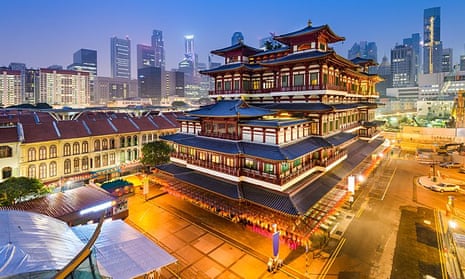Bombay is Mumbai, Léopoldville is Kinshasa, Cecil Rhodes has been hoisted from his plinth by a crane; but when I moved to Singapore a few years ago it quickly became clear that much of its colonial legacy had been left intact.
There is a gleaming white statue of Thomas Stamford Raffles, founder of modern Singapore, at the riverside spot where he is said to have landed. Unusually for a colonial figure, it was put up in 1969, four years after Singapore became an independent republic.
The country’s founding prime minister Lee Kuan Yew once said the statue reminds his people of Raffles’ vision of Singapore becoming “the emporium of the east”, adding that Singapore was different from most of its south-east Asian neighbours because it had “no xenophobic hangover” from colonialism.
It’s an attractive story. In other countries, the end of imperial rule has required a detox regime of new names and new doctrines. Singapore has taken a different path.
The Singapore model combines economic liberalism – in keeping with Raffles’ free-trading vision – a politics that subordinates the individual to the collective, and efficient government. The city’s skyline is a mix of Victorian neoclassical pomp, neon-lit office towers, and Taoist temples with bearded gods and sinuous porcelain dragons on their roofs. In this version, Singapore offers the best of both worlds: a place where Asian cultural traditions remain intact but western know-how is harnessed to build a prosperous society.
Singapore’s progress leaves a deep impression on visitors from other former colonies. When Helen Zille, a prominent South African opposition politician, visited Singapore last March she tweeted that there was much to learn from a country that had built on “valuable aspects of colonial heritage”. She went on: “For those claiming legacy of colonialism was ONLY negative, think of our independent judiciary, transport infrastructure, piped water etc.”
Zille is not alone in admiring how Singapore has exploited its imperial inheritance; from the strategic location between China and India that Raffles identified to the English language and the English common law system. Its admirers range from Deng Xiaoping to Paul Kagame, Rwanda’s president.
Unlike some other Asian nations, Singapore does not have a simple story of colonial victimhood.
For modern China the opium wars are a symbol of national abasement; the painful counterpoint to its present-day might.
The legacy of these wars in Singapore is more complex; the opium trade accounted for between 30 and 55% of the colonial administration’s revenues for most of the 19th century. It made fortunes for Chinese middlemen in south-east Asia.
Modern Singapore – which nowadays imposes the death penalty for drug trafficking – is founded on the trade in hard drugs. When Bruce Gilley, a political scientist at Portland State University, published an essay in September calling for a return to colonialism, he called on developing countries to replicate the colonial governance of their past “as successful countries like Singapore, Belize and Botswana did”.
Gilley’s essay has ignited a row between historians, with scholars mostly lining up to criticise an attempt to whitewash imperial violence.
But beyond the academic debate, Singapore shows us that colonialism can work. Its postcolonial rulers seized the advantages left them by the British empire and used them for the benefit of wider society; Singapore at independence was a profoundly unequal society in which many of its people were unskilled labourers living in slums.
It is now a rich country in which most of the population lives in municipal housing while their children attend excellent state schools. There is a further crucial difference from the colonial past; Singapore now holds elections to choose its leaders. This was not the case until near the end of British rule, when the colony was allowed a measure of self-government.
But the Singapore story also shows us the price societies pay when their rulers make use of the tools colonial authorities left behind. Under British rule, detention without trial was used to stifle the threat of communism while a licensing system kept the press contained. As many Singaporean dissidents have argued, Singapore has embraced this illiberal colonial tradition to create a tightly controlled modern state.
The consequences are a country that, while wealthy, has a chilling climate for free speech and no independent trade unions. While Singapore does hold elections, there is little space for opposition politics – human rights groups say defamation laws have frequently been used to silence opposition voices.
When Gilley and other like-minded academics endorse colonialism as a model for development, they are – in the end – making the case for a paternalist state. Western rule is not required, as Singapore shows, only an openness to modern ideas – which, in the future, will not always come from the west.
